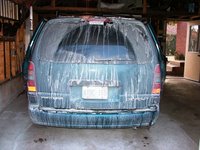

You may have read a previous post where I was remarking on some of the little differences I've noticed between Canada and Australia. Please don't think I'm passing judgement on whether one is better than the other, I'm simply noticing a few things that strike me as different, unusual or noteworthy... so here are some more.
1. Salt. Whenever it snows, the roads are almost immediately salted in order to clear the snow and make the road less slippery. Apparently salt lowers the freezing point of water and stops the ice from bonding to the roadway, so it's pretty sensible really. If you're the scientific kind you can read this more thorough explanation.
When I say they salt the roads, I don't mean they give it a light sprinkle with a salt shaker... oh no, they drive these big trucks around that literally pour huge amounts of the stuff as they drive. The salt crystals build up too, so that in carparks and in the road gutters its not unusual to see lots of salty chunks, and even when the snow stops and the weather improves, the roads still have a whitish tinge to them from all the salt. As you drive along the freeways your car gets covered - and I mean covered - with a thick crust of salt, as you can see in the photo above. However, it's the implications of the salted road that I find fascinating. As you'd expect, cars rust. A lot. It's easy to see why most of the cars on the road are fairly late model vehicles, because it's easy to understand why the older ones just fall apart. All part of living in the snow belt I guess.
2. The Metric System. Like Australia, Canada has adopted the metric system. Well, they have sort of adopted it. Speed is in kilometres. Weight is in pounds. Distance might be in kilometres, or possibly miles depending who you're talking to. Temperature is in Celsius usually, although most people seem to be comfortable with Farenheit as well. Paper sizes are measured in inches, while height is measured in centimetres. For people who were around in the pre-metric days in Australia it's not too hard to work it out, but the kids sometimes look at me blankly and ask "what's a foot?". Kate was commenting on something weighing 9 ibbs. I eventually worked out that she has seen the abbreviation for pounds, lbs, and thought the L was an I, and pronounced ibbs. :-) The really funny part is when you see both systems being used at once... I saw a 400gram box of 2-and-a-half-inch nails the other day. Classic.
3. Basements. I may have already mentioned this, but I think these are such a good idea I don't understand why all homes don't have them. Well, all Australian homes anyway. Every home here has one and Canadians look at you really oddly when you say that your home back in Australia doesn't have a basement. Basements are great for extra storage space, great for giving the kids a place to play, great for setting up your home gym, great for having an extra guest room, great for a wine cellar, great for staying cool in the summer... they are just great! Ok, so I AM passing judgement on this one. Australians, get it together! Dig before you build! I like the basement idea.
4. Drying clothes. No one here seems to have an outdoor clothes line. Of course, in winter it would be fairly pointless, since clothes don't dry too well in -15 temperatures. So everything goes in the dryer. Donna has always been a dedicated clothesline hanger, so it took her a while to get used to the fact that they just get chucked into the dryer when they come out of the wash, but now she's worked out that if you take the clothes out of the dryer while they're still warm then you don't have to iron them. I don't think she'll ever go back to the old way. In fact, I don't think we've ironed anything since we got here!
5. The cold. Ok, this is an obvious one, but you still tend to forget how much stuff is affected by the constant cold. I tried to use the garden hose the other day... Frozen. I stored some bottles of water for the water cooler in the garage and when I went to get them... Frozen. You brush snow off the car after it snows, but it just stays on the ground and doesn't melt and can be there for days or weeks. And the really amazing thing was when I snapped an icicle of a rooftop while we were in Quebec, you can touch it with your hands but the surface of it doesn't turn to water. The surface of the ice stays dry and doesn't begin to melt because the surrounding air temperature is so cold. Seems kind of obvious I guess, but for an Australian used to Australian conditions, even in what we laughingly call our "snow country" where snow and ice can be occasionally fluked into existence and then quickly melt again, the effects of the cold are quite fascinating to see.


0 Responses to “Just Different, Part 2”
Leave a Reply